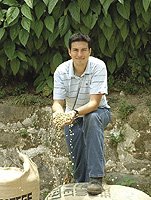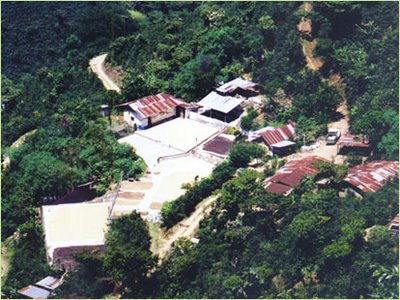a glimpse of the past. a picture of the future of coffee.
edwin martinez has feet planted in two worlds. a third generation coffee industry veteran, his family owns the finca vista hermosa. i say 'information' because when one talks with him it is immediately apparent that he knows his stuff. he's not blowing smoke trying to impress anyone with high-falutin' terminology. he's the real deal.
 i say 'wisdom' because edwin and his family of coffee growers--originally itinerant pastors in the rural backwaters of guatemala--seems to understand the absolute value of knowing just what to do with the right information. to hear him talk about the lives of the pickers, the plantation workers, the site manager--indigenous mayan, all--you get the real sense that edwin and his family genuinely care about the welfare of their people and have invested in their success in a human way rather than simply in a financially sound way...wisdom.
i say 'wisdom' because edwin and his family of coffee growers--originally itinerant pastors in the rural backwaters of guatemala--seems to understand the absolute value of knowing just what to do with the right information. to hear him talk about the lives of the pickers, the plantation workers, the site manager--indigenous mayan, all--you get the real sense that edwin and his family genuinely care about the welfare of their people and have invested in their success in a human way rather than simply in a financially sound way...wisdom.anyways, i asked edwin a short time ago to submit to another one of my email interviews and he graciously agreed. without further adieu, i give you part one of my interview with edwin martinez of finca vista hermosa.
in guatemala's famed huehuetenango region. he's seen--and participated in firsthand--all the processes that go into growing and harvesting coffee. he's also been fortunate enough to experience coffee life on the 'other side' as a retailer--he actually lives most of the year in washington state. because of these experiences, edwin martinez has amassed in his time here on earth a treasure trove of information and wisdom about nearly every aspect of the so-called seed to cup chain.

********************
1. talk about your family's origins in the coffee industry.
In 1957 my grandfather was pastoring a church in the city of Huehuetenango and he hiked around the entire department of Huehuetenango and planted many other churches. Yes,the city has the same name as the department, which is like a state in U.S. or a province in Canada. Consequently, there were probably few people that knew the area better than he. One day a man who needed money offered his land to my grandfather. Although he couldn’t afford it, they worked something out. My grandmother Martha was very resourceful and found other ways to generate some income that soon exceeded Felipe’s salary as a pastor. They got 10 cents per pair of pants they made at home, usually between 4:00 and 6:00 a.m. before their day started. While raising 7 kids is a lot of work, eventually the kids became very helpful at home. My father and his brothers and sisters all have memories of accompanying my grandfather to the first parcel they purchased. It was a 7 hr bus ride and hike to do what now is driven in less than 2 hrs. Keep in mind that last hour of driving today is only 16km. The roads are still rustic today. Today in the specialty market more coffee comes to the U.S. from Huehuetenango that any other region in the world. All this coffee changes hands numerous times at origin and most of these “hands” belong to folks who were high school class mates of my fathers and his siblings. That’s my families origins with coffee. Me on the other hand, I’m still very green. I’ve a long way to go to pay my dues.
2. what is the most cutting edge thing you've seen in coffee? where
are we going?
You. That’s an easy one. For us coffee runs in our veins, it is in our blood. Passion is more than a choice. But folks like you who dive into the industry head first and make it your life. This is what is guiding where we are going. Even for me, the circumstance I exist in is because of blood, sweat and tears of those before me. It is quite a responsibility that should not be taken lightly.
3. what is the most critically important thing coffee consumers
(importer/exporters, buyers, roasters, consumers) don't know about
coffee growers?
Growers are the only link in the chain that generally don’t make a living when the market is down. Every single link in the chain after the grower, be it 6 or 26 links between grower and the cup, has margins and can make a living under any market conditions. In the U.S. during the Great Depression, spending went down on EVERYTHING except coffee. When everyone had to cut way back on everything, SPENDING ON COFFEE ACTUALLY WENT UP! It’s one of life’s precious luxuries that seem to always be affordable to all, yet every day there are growers going bankrupt.
4. what was the most important step you've taken at finca vista
hermosa to increase coffee quality?
Stepped away. In Guatemala, most people picking coffee are 100% Mayan and most managers/owners are not. By hiring Mayan managers, trusting them completely, and treating them with respect like family, this is not only reciprocated but passed on, creating an atmosphere like none other. Many other local growers have asked what we do differently that makes the difference in quality. Sure, we can make a list of things, but the bottom line is people. Happy people make the difference. And it’s not just paying more either.
5. you've mentioned before in your roast magazine interviews that honesty is the biggest key to meaningful coffee relationships. give
me an example where honesty was a very difficult choice to make.
The practice of swapping is ethically wrong and is often a tough decision. We have a limited crop and that [when it] is sold out, it would not be too hard to sell “more of our coffee” when in fact there is no more. In Huehue when a buyer is considering some coffee, the samples before and after carry much weight in the transaction. Otherwise the same premium lot of coffee will be sold 10 times to 10 different parties, when there is clearly only one lot in existence where samples were pulled from. This is just as if we had a customer who sold much more FVH than they bought from us. (Don’t get any ideas or I’ll come after you with a machete.)
6.what are some of the challenges quality-minded farmers are faced
with in getting their coffee onto the international market?
One of the greatest challenges is lack of logistics and connection to quality-driven, educated buyers. Quality is only valued when compensation reflects the quality. In most cases there are way too many links or there’s lack of transparency. Thus incentive to continue producing quality is gone. Also, even with a relationship direct with a quality buyer, if price is a premium on the C, then the price is not sustainable… It can be too low when market is low, and on the consumer side it can also be too high when market it high just the same.
Intelligentsia has taken a bold step with their Direct Trade program. I recall a conversation with [Intelligentsia founder] Doug Zell a few years back where they had a contract for a Guat where the market went up and a few containers of their coffee disappeared! Most would say, “You can’t win em all” and try to make up the loss buying a forward contract on another coffee when the market is down. But in the end it’s a frustrating game where half the time one side ends up a big winner and the other a big loser. What kind of a relationship is that? It’s not a relationship! With their Direct Trade program it’s simply always paying a good price for good coffee. It’s not rocket science, but you have to both agree to mutually share the risk and the reward of stability and it takes much more time and effort than most are willing to invest. Doug Zell was not the first to lose contracted coffee, but they are certainly taking steps to avoid this in the future.
7. i've heard you talk about how taking a short cut here or cutting
back there during a particular growing season can have long term
devastating effects on a coffee product. what are some examples you
can share of this?
This is beyond common. It’s quite standard that when the market dips below cost of production, one naturally holds back on spending. So if you skip out on key activities such as fertilizing, pruning, weeding or picking, future crop qualities are compromised. You may wonder why one would skip picking? It is the most costly activity of the year, and if the market price at the time are below the cost of production, often crops are either abandoned or sometimes burned so a more sustainable crop other than coffee can be planted. Any of these activities skipped, particularly if done a few years in a row, will take 3-6 years to recover assuming it is still possible or even cost effective.
********************
in part two of my interview with edwin, we get into the role of the coffee coyote, the fair trade movement from a grower's perspective, what a typical day on the finca looks like, and much more. stay tuned....

0 Comments:
Post a Comment
<< Home